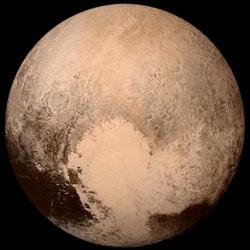
Pluto just can’t stop blowing our minds. Not only is the dwarf planet a geologically active world with ice mountains the size of the Rockies and frozen plains of methane and nitrogen, we’ve just learned that Pluto’s atmosphere is pouring away into space. It’s leaving a massive tail of charged plasma in its wake.
That’s one of the latest fascinating Pluto dispatches that NASA’s New Horizons science team shared at a press conference this afternoon. Beginning an hour and a half after its closest approach to Pluto on Tuesday, the New Horizon’s Solar Wind Around Pluto (SWAP) instrument began detecting a ‘plasma tail,’ rich in ionised nitrogen molecules that are presumably being stripped away from the dwarf planet’s atmosphere.
The tail, which extends tens of thousands of miles beyond Pluto, is probably the result of solar winds charging up molecules in the planet’s atmosphere and punting them off into space. Or, in NASA’s words: “What we think is happening is that the solar wind from the sun, charged particles streaming out at supersonic speeds, are interacting with this escaping atmosphere, producing a shock upstream.”
“We’ve already observed an upstream amount of energized nitrogen ions carried away by the solar wind,” said New Horizons co-investigator Fran Bagenal at today’s press conference. How fast of a leak are we talking? According to Bagenal, Pluto could be losing atmosphere at a rate of 500 tonnes per hour. For comparison, Mars’ thin atmosphere is only escaping into space at a speed of roughly 1 tonne per hour. The substantially faster loss of Pluto’s atmosphere is probably due to the tiny planet’s weak gravity.
But these numbers are just rough estimates at this point. So far, all we know is that there’s a massive, ionised bubble of particles surrounding Pluto, and we can make some good inferences about how it got there. When we get more data back in August, Pluto’s science team will be able to put some hard numbers to this fascinating phenomenon.
